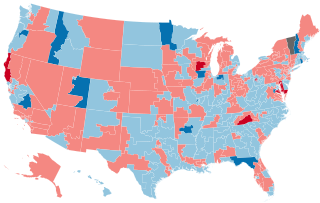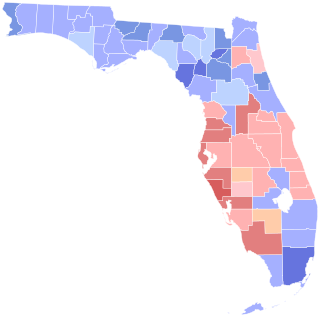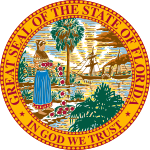
Daniel Robert Graham was an American lawyer, author, and politician who served as the 38th governor of Florida from 1979 to 1987 and a United States senator from Florida from 1987 to 2005. He was a member of the Democratic Party.

Paula Hawkins was an American politician from Florida. She is the only woman elected to the U.S. Senate from Florida. She was the second woman ever elected to the Senate from the American South. She was the first woman in the country to be elected to a full Senate term without having a close family member who previously served in major public office.

The 1998 United States Senate elections were held on November 3, with the 34 seats of Class 3 contested in regular elections. This was seen as an even contest between the Republican Party and Democratic Party. While the Democrats had to defend more seats up for election, Republican attacks on the morality of President Bill Clinton failed to connect with voters and anticipated Republican gains did not materialize. The Republicans picked up open seats in Ohio and Kentucky and narrowly defeated Democratic incumbent Carol Moseley Braun, but these were cancelled out by the Democrats' gain of an open seat in Indiana and defeats of Republican Senators Al D'Amato and Lauch Faircloth. The balance of the Senate remained unchanged at 55–45 in favor of the Republicans.

The 1992 United States Senate elections, held November 3, 1992, were elections for the United States Senate. The 34 seats of Class 3 were contested in regular elections, along with special elections to fill vacancies. They coincided with Bill Clinton's victory in the presidential election. This was the first time since 1956 that the balance of the Senate remained the same.

The 1986 United States Senate elections were elections for the United States Senate. Held on November 4, in the middle of Ronald Reagan's second presidential term, the 34 seats of Class 3 were contested in regular elections. The Republicans had to defend an unusually large number of freshman Senate incumbents who had been elected on President Ronald Reagan's coattails in 1980. Democrats won a net of eight seats, defeating seven freshman incumbents, picking up two Republican-held open seats, and regaining control of the Senate for the first time since January 1981. This remains the most recent midterm election cycle in which the sitting president's party suffered net losses while still flipping a Senate seat.

The 1980 United States Senate elections were held on November 4, coinciding with Ronald Reagan's victory in the presidential election. The 34 Senate seats of Class 3 were contested in regular elections. Reagan's large margin of victory over incumbent Jimmy Carter gave a huge boost to Republican Senate candidates, allowing them to flip 12 Democratic seats and win control of the chamber for the first time since the end of the 83rd Congress in January 1955.

The 1974 United States Senate elections were held on November 5, with the 34 seats of Class 3 contested in regular elections. They occurred in the wake of the Watergate scandal, Richard M. Nixon's resignation from the presidency, and Gerald Ford's subsequent pardon of Nixon. Economic issues, specifically inflation and stagnation, were also a factor that contributed to Republican losses. As an immediate result of the November 1974 elections, Democrats made a net gain of three seats from the Republicans, as they defeated Republican incumbents in Colorado and Kentucky and picked up open seats in Florida and Vermont, while Republicans won the open seat in Nevada. Following the elections, at the beginning of the 94th U.S. Congress, the Democratic caucus controlled 60 seats, and the Republican caucus controlled 38 seats.
This article covers the history of women in the United States Senate and various milestones achieved by female senators. It includes a list of all women who have served in the Senate, a list of current female senators, and a list of states represented by women in the Senate. The first female U.S. senator, Rebecca Latimer Felton, represented Georgia for a single day in 1922, and the first woman elected to the Senate, Hattie Caraway, was elected from Arkansas in 1932. Sixty women have served in the upper house of the United States Congress since its establishment in 1789. As of October 3, 2023, there are 25 women serving as U.S. senators. Additionally, Kamala Harris as vice president serves as President of the Senate.

The 1970 United States Senate elections was an election for the United States Senate. It took place on November 3, with the 33 seats of Class 1 contested in regular elections. Special elections were also held to fill vacancies. These races occurred in the middle of Richard Nixon's first term as president. The Democrats lost a net of three seats, while the Republicans and the Conservative Party of New York picked up one net seat each, and former Democrat Harry F. Byrd Jr. was re-elected as an independent.

The 1968 United States Senate elections were elections for the United States Senate. Held on November 5, the 34 seats of Class 3 were contested in regular elections. They coincided with the presidential election of the same year. The Republicans picked up five net seats in the Senate. This saw Republicans win a Senate seat in Florida for the first time since Reconstruction.

The 2002 United States House of Representatives elections were held on November 5, 2002, in the middle of President George Walker Bush's first term, to elect U.S. Representatives to serve in the 108th United States Congress. This was the first congressional election using districts drawn up during the 2000 United States redistricting cycle on the basis of the 2000 census.

The 1992 United States House of Representatives elections were held on November 3, 1992, to elect U.S. Representatives to serve in the 103rd United States Congress. They coincided with the 1992 presidential election, in which Democrat Bill Clinton was elected as President, defeating Republican incumbent President George H. W. Bush.

The 1990 United States House of Representatives elections was an election for the United States House of Representatives on November 6, 1990, to elect members to serve in the 102nd United States Congress. They occurred in the middle of President George H. W. Bush's term. As in most midterm elections, the President's Republican Party lost seats to the Democratic Party, slightly increasing the Democratic majority in the chamber. It was a rare instance, however, in which both major parties lost votes to third parties such as the Libertarian Party as well as independent candidates.

The 1992 United States House of Representatives elections in South Carolina were held on November 3, 1992, to elect the six U.S. representatives from the state of South Carolina, one from each of the state's six congressional districts. The elections coincided with the 1992 U.S. presidential election, as well as other elections to the House of Representatives, elections to the United States Senate and various state and local elections.

The 1988 United States Senate election in Florida was held on November 8, 1988. Incumbent Democratic U.S. Senator Lawton Chiles decided to retire instead of seeking a fourth term. Republican Connie Mack III won the open seat, becoming the first Republican to hold this seat since Reconstruction in 1875.

The 1998 United States Senate election in Florida was held November 3, 1998 alongside other elections to the United States Senate in other states as well as elections to the United States House of Representatives and various state and local elections. Incumbent Democratic U.S. Senator Bob Graham won re-election to a third term. As of 2024, this was the last time a Democrat has won the Class 3 Senate seat from Florida, and the last time a non-Hispanic won the Class 3 Senate seat from Florida.

The 1992 United States Senate election in Florida took place on November 3, 1992 alongside other elections to the United States Senate in other states as well as elections to the United States House of Representatives and various state and local elections. Incumbent Democratic U.S. Senator Bob Graham won re-election to a second term.

The 1986 United States Senate election in Idaho took place on November 4, 1986 alongside other elections to the United States Senate in other states as well as elections to the United States House of Representatives and various state and local elections. Incumbent Republican U.S. Senator Steve Symms narrowly won re-election to a second term. As of 2023, this remains the last time that a Senate election in Idaho has been decided by a single-digit margin. This election was the first time since 1926 that an incumbent Republican Senator from Idaho was re-elected to this seat.

The 1980 United States Senate election in Florida took place on November 4, 1980, alongside other elections for President of the United States as well as to the United States Senate in other states and elections to the United States House of Representatives and various state and local elections. Incumbent Democratic U.S. Senator Richard Stone ran for re-election to a second term, but lost the Democratic primary election to Bill Gunter. Republican Paula Hawkins defeated Gunter in the general election.

The 1974 United States Senate election in Florida was held on November 5, 1974. Incumbent Senator Edward Gurney, a Republican, declined to seek a second term after being indicted for taking bribes in return for his influence with the Federal Housing Administration. The primary for the Republican nomination pitted Eckerd drug store owner Jack Eckerd against Florida Public Service Commissioner Paula Hawkins. Eckerd won handily, receiving approximately 67.5% of the vote. The Democratic primary, however, was a crowded field with eleven candidates vying for the nomination. Because no candidate received a majority of the votes, U.S. Representative Bill Gunter and Secretary of State of Florida Richard Stone advanced to a run-off election. Stone won by a small margin of 1.68%.






















